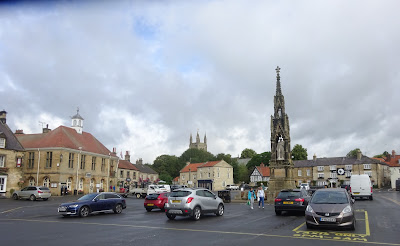 |
| IJ VM Helmsley |
Helmsley is a market town in the North Riding of Yorkshire on the River Rye where it joins the Vale of Pickering.
 |
| Helmsley |
 |
| Helmsley - Dinner View |
Hemsley Castle is situated on a rocky outcrop overlooking the River Rye.
 |
| Helmsley Castle |
The first fortifications on the site were constructed in wood around 1120. The castle was developed over the centuries to become a strong fortification with outer and inner defences.
 |
| Helmsley Castle Fortifications |
During the English Civil War Helmsley Castle was a Royalist stronghold in North Yorkshire.
The Northern Royalist Army was defeated at Marston Moor on 2nd July 1644. With the field army destroyed, the remaining Royalist strongholds were left unprotected. The Parliamentarian Army looked to take advantage of the situation.
The Scottish Covenanters Army aligned to the Parliamentarian's marched north under the command of Lord Leven with the aim of laying siege to Newcastle. The Eastern Association Army withdrew commanded by the Earl of Manchester with drew south capturing Tickhill Castle (near Doncaster) and Sheffield Castle.
Lord Fairfax and the remaining Parliamentarian forces in Yorkshire began clearing the remaining Royalist Garrisons. Their first action was to lay siege to Helmsley Castle. The siege began in August 1644 and lasted till November when the Royalists surrendered.
 |
| Siege of Helmsley Castle |
Parliament ordered the castle to be destroyed to prevent being used again as a fortified garrison. The walls, gates and part of the east tower were destroyed, though some parts were spared.
 |
| Helmsley Castle Ruins |
The town hall was built in 1901 bears a plaque dedicated to soldiers lost during the First World War who served with the 21st (Service) Battalion (Yeoman Rifles) of the King's Royal Rifle Corps who had died in the war.
 |
| Helmsley Town Hall |
 |
| Helmsley Town Hall Memorial Plaque 21st (Service) Battalion (Yeoman Rifles) King's Royal Rifle Corps |
The 21st KRRC was raised by the Earl of Feversham at Duncombe Park, Helmsley. It was formed in September 1915 from volunteers from the farming communities of Yorkshire, Northumberland and Durham by the Northern Command. The unit was commanded by Lieutenant-Colonel Charles William Reginald Duncombe, the second Earl of Feversham.
Earl and Countess of Feversham with officers NCOs and men who enlisted in the 21st King’s Royal Rifles Corps from Helmsley, before they left for active service in May 1916.
The battalion moved to Aldershot In January 1916 and joined 124 Brigade in the 41st Division. The division landed in France on 4 May 1916. They were involved in the later Battles of the Somme, Flers-Courcelette and Transloy Ridges.
Lieutenant-Colonel Charles William Reginald Duncombe, the second Earl of Feversham was killed in action on 15 September 1916 on the opening day of the battle as the 21st KRCC attacked towards Flers. He was leading the battalion while under heavy machine gun and rifle fire on an assault on a German trench when he was shot.
He is buried in the A.I.F. Burial Ground, Flers
CWGC Lieutenant Colonel Charles William Reginald Duncombe
%20Battalion%20(Yeoman%20Rifles),%20King's%20Royal%20Rifle%20Corps.jpg) |
| Lt Col CWR Duncombe Earl of Faversham |
In 1917 the 21st KRRC were engaged in the Battle of Messines, and during the Third Battles of Ypres, the Battle of Pilkem Ridge and the Battle of the Menin Road. They then moved to the Nieuport sector and involved in Operations on the Flanders coast.
In November 1917 the 41st Division was transferred to Italy. There the units concentrated north west of Mantua. The Division took over a sector of front line behind the River Piave, north west of Treviso, between 30 November and early on 2 December.
The 41st Division returned to France in early March 1918. The reorganisation of the British Army which reduced Divisions form four brigades to 3 brought about the disbandment of the 21st KRRC on 16 March 1918.
